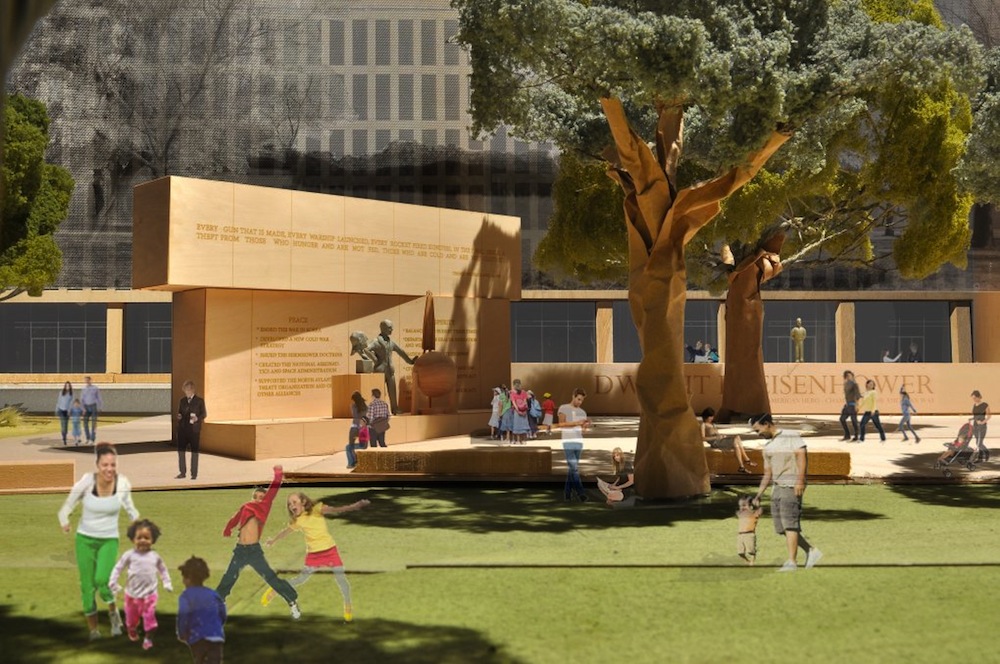The design for the long-delayed Eisenhower Memorial by famed architect Frank Gehry received final approval from a Washington planning commission on Thursday, though disputes over costs may keep the $142 million work from ever being built.
Planned for years for a spot just off the National Mall, a short walk from the U.S. Capitol, the memorial has been plagued by delays and cost overruns. Congress has cut off construction funds for the project for three years in a row.
The National Capital Planning Commission passed the design by a 10-1 vote on Thursday.
"We think it's good urban design. It's good for the entire Southwest neighborhood," said Mina Wright, a commission member representing the General Services Administration's Office of Planning and Design Quality, who voted in favor of the design.
Despite the vote, funding for the project remains uncertain and faces deep congressional skepticism. Congress has already spent at least $65 million on the memorial. A report by the House of Representatives Natural Resources Committee last year described it as a "Five-Star Folly".
The design includes a pair of 80-foot (24-meter) columns and a 447-foot (136-meter) steel mesh tapestry depicting the Kansas plains where the 34th U.S. president and World War Two Allied commander grew up. It is expected to take up 4 acres (1.62 hectares).
Gehry's use of tapestries instead of traditional statuary has drawn the most criticism, especially from Congress and the Eisenhower family. The design approved by the panel scrapped two of the original steel tapestries but kept two supporting columns.
"Congress doesn't want this design. The public doesn't want this design," said Justin Shubow, president of the National Civic Art Society, an outspoken critic of the memorial project.
Congress authorized the memorial in 1999 and set a completion date of 2007.
Gehry, 86, is perhaps best known for the dramatic Guggenheim Museum in Bilbao, Spain.
(Reporting by Lacey Johnson; Editing by Edward McAllister and Eric Walsh)
Related Stories
| Aug 11, 2010
AASHE releases annual review of sustainability in higher education
The Association for the Advancement of Sustainability in Higher Education (AASHE) has announced the release of AASHE Digest 2008, which documents the continued rapid growth of campus sustainability in the U.S. and Canada. The 356-page report, available as a free download on the AASHE website, includes over 1,350 stories that appeared in the weekly AASHE Bulletin last year.
| Aug 11, 2010
Girl Scouts of San Jacinto Council Program Place Project
Houston, Texas
The Girl Scouts of San Jacinto Council Program Place is the headquarters for the largest Girl Scout Council in the U.S., with 63,000 scouts. The building houses the council’s administrative offices, a Girl Scout museum, and activity space. When an adjacent two-story office building became available, the council jumped at the chance to expand its museum and program space.
| Aug 11, 2010
Burt Hill, HOK top BD+C's ranking of the nation's 100 largest university design firms
A ranking of the Top 100 University Design Firms based on Building Design+Construction's 2009 Giants 300 survey. For more Giants 300 rankings, visit http://www.BDCnetwork.com/Giants
| Aug 11, 2010
PBK, DLR Group among nation's largest K-12 school design firms, according to BD+C's Giants 300 report
A ranking of the Top 75 K-12 School Design Firms based on Building Design+Construction's 2009 Giants 300 survey. For more Giants 300 rankings, visit http://www.BDCnetwork.com/Giants
| Aug 11, 2010
Turner Building Cost Index dips nearly 4% in second quarter 2009
Turner Construction Company announced that the second quarter 2009 Turner Building Cost Index, which measures nonresidential building construction costs in the U.S., has decreased 3.35% from the first quarter 2009 and is 8.92% lower than its peak in the second quarter of 2008. The Turner Building Cost Index number for second quarter 2009 is 837.
| Aug 11, 2010
AGC unveils comprehensive plan to revive the construction industry
The Associated General Contractors of America unveiled a new plan today designed to revive the nation’s construction industry. The plan, “Build Now for the Future: A Blueprint for Economic Growth,” is designed to reverse predictions that construction activity will continue to shrink through 2010, crippling broader economic growth.
| Aug 11, 2010
Section Eight Design wins 2009 Open Architecture Challenge for classroom design
Victor, Idaho-based Section Eight Design beat out seven other finalists to win the 2009 Open Architecture Challenge: Classroom, spearheaded by the Open Architecture Network. Section Eight partnered with Teton Valley Community School (TVCS) in Victor to design the classroom of the future. Currently based out of a remodeled house, students at Teton Valley Community School are now one step closer to getting a real classroom.







